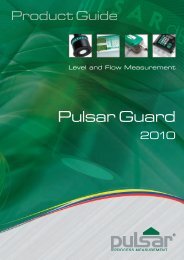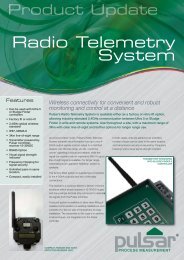FlowCERT
Flow Cert Second Edition.pdf - Pulsar Process Measurement
Flow Cert Second Edition.pdf - Pulsar Process Measurement
- No tags were found...
You also want an ePaper? Increase the reach of your titles
YUMPU automatically turns print PDFs into web optimized ePapers that Google loves.
V-notch angle weirs, the head is measured upstream of the weir plate at a<br />
minimum distance of 3 times maximum head to ensure the surface of the<br />
liquid is not effected by turbulence or drawdown. See Exponential devices,<br />
above, for further details.<br />
Calculations<br />
Palmer Bowlus Flume and H-Flume<br />
ABSOLUTE<br />
If the flow calculation is to be absolute P702 = 1 the flow will be calculated<br />
using the formula: q = f(h)<br />
Where: q = flowrate<br />
f = is an 8 th degree polynomial solution for h (head)<br />
RATIOMETRIC<br />
If the flow calculation is to be ratiometric P702 = 2 the flow will be<br />
calculated using the formula: q= q cal f(h)/f(h cal )<br />
Where: q = flowrate<br />
q cal = flowrate at maximum head P705<br />
f(h) = a polynomial solution for h (head)<br />
f(h cal ) = a polynomial solution for h cal (maximum head)<br />
V-Notch Angle Weir (Non BS 3680)<br />
ABSOLUTE<br />
If the flow calculation is to be absolute P702 = 1 the flow will be calculated<br />
using the formula: q = C e 8/15 tan (theta/2)(2gn) 0.5 (h = kh) 2.5<br />
Where: q = flowrate<br />
C e = discharge coefficient calculated by <strong>FlowCERT</strong> P723<br />
theta = V-notch angle<br />
gn = gravitational acceleration<br />
h = head<br />
kh = compensated head<br />
Page 75









